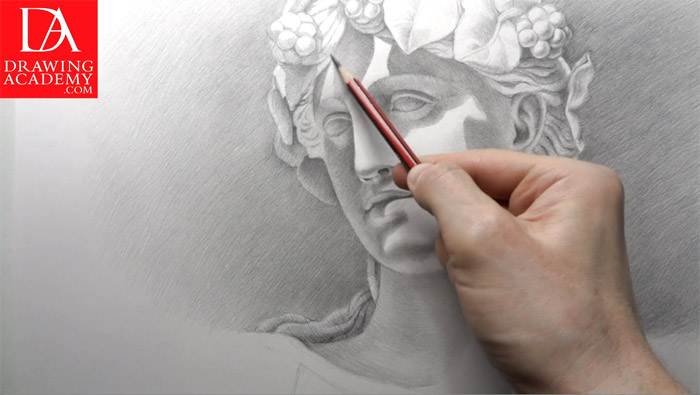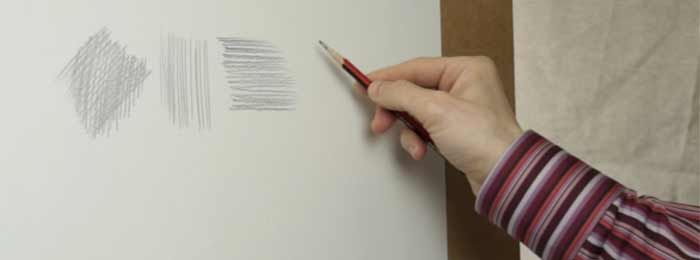Question from Yuri Magalhaes, Drawing Academy Student
Dear Vladimir,
In the video “How to Hold a Pencil“, you talk about the “writing grip”. That’s what I use, since I focus more on small pieces. For the rendering, should I hatch with bent fingers like you show, or is it acceptable to make each stroke from the wrist?
I notice my rendering gets too dark right from the beginning of the work, and I don’t know if it is because of the hand-finger movement that I haven’t been able to master the line weight.
Is there any exercise other than filling up an entire sketchbook with hatching practice to master the technique?
One more thing. I see that you use a Canberand Pencil, but I can’t find that brand online. My country has no strong history of artwork, so I know I’ll never find it in my local stores. I have direct access to Koh-I-Noor, Staedtler Lumograph, Toison D’or and (buying online) Derwent. But I couldn’t even find that Canberand online. Can you direct me somewhere I could find it?
Thank you!
Best Regards,
Yuri
Dear Yuri,
Many thanks for your questions.
Yes, you are right about holding a pencil using a “pen grip” for small pieces. It is perfectly fine to employ that grip to achieve the precision you want for small-scale drawings. I am guessing that your drawing board is in the horizontal (or tilted) position when you make those artworks.
For larger drawings, it is better to have an upright drawing board (easel) position and to hold the pencil with the “candle” grip. Keeping the drawing board in the vertical position will give you a better view of the drawing, and the easel can be positioned so you can see the model and the drawing at the same time.
When rendering with a “candle grip,” you can move your hand from the shoulder or elbow. For smaller drawings, do wrist movements, and to draw delicate details, move the pencil by bending fingers.
Drawing by bending your fingers becomes important when doing drawings in pen and ink, working on calligraphy, and silverpoint drawings.

You mentioned that your rendering is very dark from the beginning. You need to reduce pressure on the pencil and make lighter strokes.
It is important to feel your drawing tool and understand how to get the full range of tonal values that one pencil grade can provide. Starting out at full strength gives you very little room to depict all the nuances possible by gradually building-up tonal values.
This is a common mistake that art students make, even in art colleges and schools. There’s one well-known art school in London (I won’t name it, to keep its reputation intact), where students haven’t been taught how to use pencils. I discussed this matter with their teachers; they were more concerned to teach ‘creativity’ rather than the essential skills that every proficient artist must have.
Here’s a good exercise you can do to develop a “feeling” for a given pencil. Take a pencil of whatever grade you choose; for this example, let’s say HB. Sharpen it well with a pencil knife (not a pencil sharpener) and draw a long vertical rectangle (with at least five times the length-to-width ratio). Render this rectangle starting at the top, with tonal gradients ranging from very dark to very light. This continuous gradient should be made in multiple layers of hatching. Start at what will become the dark part of the rectangle. Don’t use full strength at the outset; instead, gradually build up the tonal values, little by little, layer by layer. Advance from dark tones to mid-tones, and final light tones; apply light pressure pencil strokes. Your aim is to achieve a very smooth gradation, from the darkest tone the pencil can provide to blank white paper at the bottom. Make another rectangle, this time with a harder pencil grade – 2H, for example. Repeat the exercise with a softer grade, 2B.

Then, try to render horizontal rectangles. Vary the gradient direction, practicing moving from dark on the left to light on the right, and dark on the right to light on the left.. Use the pencil grades and brands you want to test and plan to use in your future drawings.
It is a laborious and boring task, but take my word for it, a full year at the London art school I mentioned above will not give you better rendering skills than you will get by hatching these rectangles at home.
In regard to your question about pencil brands, I would suggest not chasing some “elusive brand” that will make your drawings perfect. Your drawing skills are in your head, eyes, and hand; they do not depend on pencil manufacturers. I’m sure that you will agree that a proficient fine artist will create much better works of art with the worst pencil on the market than an amateur with the best brand.
Get the most expensive graphite pencils you can find at your local art shop; pencils are cheap anyway. When I was an art student, Koh-I-Noor was high on my wish-list. I still like it for its quality and consistency.
I hope you found this feedback useful. Keep in touch and let us know how your rendering skill develops.
To your creative success,
Vladimir London
Drawing Academy Tutor






Dear vladmir,
Thank you so much for mentioning about how to improve rendering skills using pencil.Even I have got an idea from u r valuable reply to yuri.
Thank you !
Best regards,
Shahbaz
Stunning. Of all the art classes I have had (none teaching even how to hold a pencil much less in rendering in four years) this is possibly the most formative information I have received regarding how to render with a pencil. Too many You Tubes and even art books never expose this level of percision regarding how to render with a pencil. After years of attempting to draw and render I am eager to spend time daily working on this exercise. Thank you ever so much for this beautiful vigenitte.